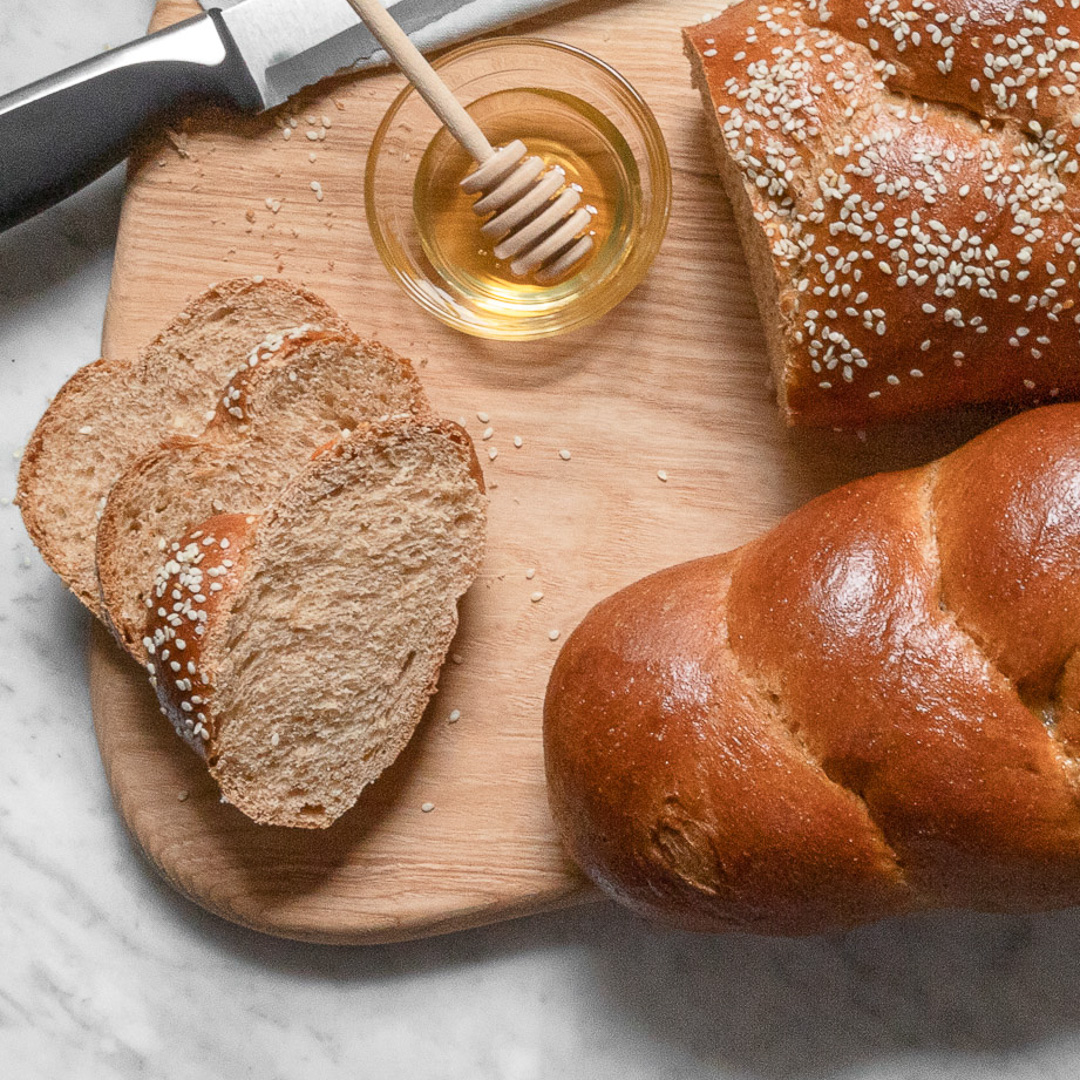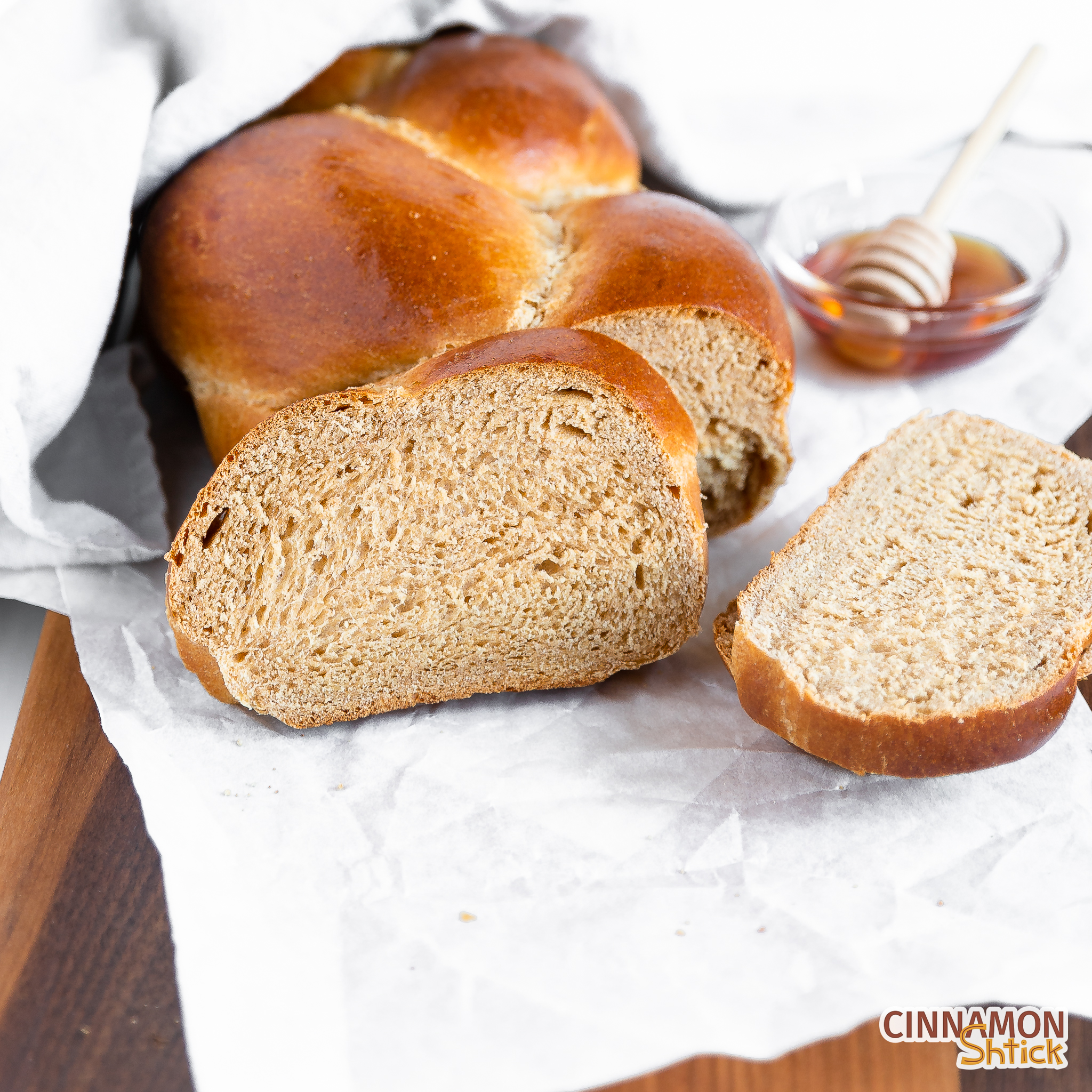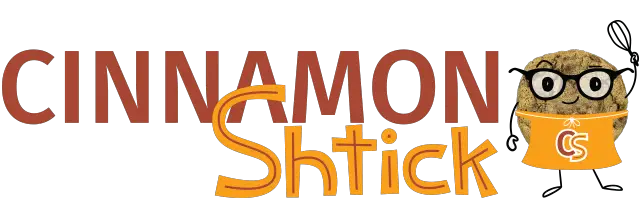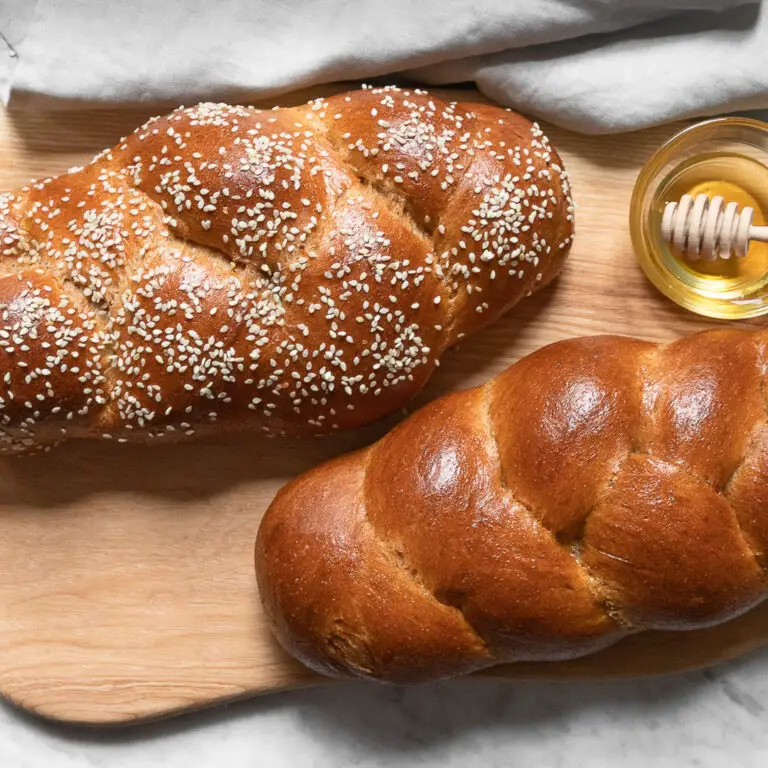This post may contain affiliate links. As an Amazon Associate, I earn from qualifying purchases. For more information, please visit my Privacy Policy.
Until recently, whole wheat flour was a bit of a mystery to me. I don’t know why. I just rarely baked with it and never really looked into it or how it works. Of course, I knew that it has more nutrients than all purpose or bread flour, but I have never been one to long for the taste of whole wheat. I also never found a great whole grain challah recipe, especially a whole wheat challah recipe.
Can’t Find a Good Challah Recipe? Then Create It!
I started to really bake with whole wheat when I hopped on the sourdough bandwagon several months ago. Mixed with all purpose or bread flour, it was very enjoyable! That’s how and why I developed a Honey Whole Wheat Sourdough Bagel.
That lead me to a whole wheat challah. I have enjoyed so many challah recipes over the years, but I never really came across a whole wheat one – at least not that resulted in a delish challah. So, I embarked on converting my Challah recipe into a whole wheat one. (I took a similar path to create my Spelt Challah recipe too!)

Problems With Using Whole Wheat
Making the same mistake as so many do, without doing any research, I subbed out the bread flour in my Challah recipe for whole wheat flour. Boy, was I disappointed! But, at least that forced me to research. In a nutshell, here is what I learned:
Wheat kernels contain three basic parts: the germ, the bran and the endosperm. Most of the nutrients are found in the germ and the bran. All purpose and bread flour are made from the endosperm, which is the largest part of the kernel. Unlike those flours, whole wheat contains the germ, the bran and the endosperm. You’re probably thinking that you did not sign up for this nerd class. Settle down. This is important stuff!
So, why does it matter that whole wheat flour contains the entire kernel, including the germ and the bran? Drum roll please…
Well, there are three key reasons why this nerd stuff is important:
First, the germ and the bran make the flour heavier than all purpose or bread flour. Without making changes to a recipe to accommodate for that extra weight, the bread could not rise and/or be very dense.
Second, the bran is actually sharp in texture. Put your hand in a bag of whole wheat to see for yourself. When you knead a whole wheat bread to develop and stretch the gluten, you are also pushing those sharp bran pieces into the dough, causing the gluten to be cut. For this reason, it is important not to over-knead whole wheat breads.
Third, the germ and the bran are super water absorbers. To accommodate for this, we need to add much more water than we use for a recipe with all purpose or bread flour.
Solutions for Baking with Whole Wheat
To correct these problems, I added much more water to my challah recipe. Also, instead of kneading, I let the dough sit just after it is mixed with all the other ingredients (except the salt) so that all the flour gets hydrated. (Further Nerd Alert: We hold off on adding the salt because when first introduced to yeast, it could kill or slow down the yeast from developing. It also absorbs water, and we do not want the salt to compete with the flour getting hydrated.) Then, instead of kneading and risking the bran from cutting the gluten, I did a couple sets of folds.
I know, I know. You’re asking, “What’s a fold?”
Fold Whole Wheat Dough
A fold is when you grab the dough from the bottom of the bowl and pull it up and over to the center of the top of the dough. Generally, you do 4 folds at a time, rotating your bowl 90° after each fold. This helps stretch the gluten without actually kneading.
Add Gluten
There was one last change I had to make from my regular Challah recipe. Even though whole wheat flour contains approximately the same amount of protein as bread flour, as I mentioned earlier, it is difficult to develop the gluten in whole wheat flour. To assist with this issue, I added vital wheat gluten. Say what?!?!
Vital wheat gluten is basically gluten taken from the wheat. By adding just a bit of gluten to the recipe, together with more water, we get the same bready feel and texture as with bread flour, resulting in a soft, traditional challah. You can find vital wheat gluten at any grocery store in the baking aisle. There are a number of different brands. The one I most often see and always buy is Bob’s Red Mill Vital Wheat Gluten.
Tips for Making Whole Wheat Challah
This whole grain challah dough is really quite simple to make. Here are a few tips to help you out:
- I like to use the stand mixer for the initial mixing of the dough, even though we are not kneading it for long in the mixer. I just find that it is easier and cleaner, especially when kneading in the salt. You could definitely do the initial mix by hand or with with a Danish dough whisk. I love these whisks and use them especially when I make sourdough breads.
- Be sure to scrape down the side of the bowl as you mix and after the two sets of folds. These Ateco bowl scrapers are cheap, wonderful, and my brand of choice. (If you are looking to buy the Danish dough whisk and a scraper, there is a package deal on Amazon for them but I find the bowl scraper in this package not to be as good as the Ateco ones.
- When shaping the challah into strands for braiding, lightly dust the strands with additional whole wheat flour if the dough is sticky. This will help the dough to keep its shape better when baking.
- To know when the challah is fully baked, it is best to take its temperature. You want the very middle of the challah to reach at least 190° F. I highly recommend using a Thermapen thermometer from ThermoWorks. I have several that I use for bread baking, ice-cream making, and cooking chicken and meat. To say that I love the Thermapen One is an understatement, and this is just my own personal opinion.

Looking for a round Challah or just an ornate challah? Check out my Festive Challah or my 4-Strand Round Challah.
Want a variation on this whole grain challah? Check out my Spelt Challah.
For my traditional recipe (not whole grain), check out my Challah.
For a softer, doughier challah, check out my Tangzhong Challah.
Sourdough fans, check out my Sourdough Challah.
For an egg-free or vegan version, check out my Vegan Challah.
Looking to use up the leftover egg whites? Check out my Chocolate Egg White Cake, which is an easy and wonderful parve (dairy free) dessert ideal for any Shabbat or Yom Tov.
Frequently Asked Questions About Making Whole Wheat Challah
Can I use part whole wheat and part bread flour?
If you do not want to make a 100% whole wheat challah, but instead wish to use some whole wheat for flavor, make my traditional Challah recipe instead, subbing in no more than 50% of whole wheat flour for bread flour.
Why is the whole wheat challah dough slightly sticky?
This Whole Wheat Challah recipe uses more water than my traditional Challah recipe because whole wheat flour need to absorb more water. This is the reason this recipe has more resting time and less active kneading. By the time you shape the challah, the dough will still be slightly sticky, but should be capable of being shaped. Be sure to lightly flour the countertop and your hands when shaping and use a bowl scraper or bench cutter to lift the dough from the countertop.

Whole Wheat Challah
Ingredients
- 185 grams warm water (¾ cup)
- 4 grams active dry yeast or instant yeast (1½ teaspoons)
- 3 egg yolks, at room temperature
- 43 grams oil (neutral, such as canola, vegetable, sunflower) (3 Tablespoons plus 1 teaspoon)
- 30 grams sugar (2 Tablespoons plus 1 teaspoon)
- 68 grams honey (3 Tablespoons plus 1 teaspoon)
- 390 grams whole wheat (2¾ cups + 1½ Tablespoons)
- 12 grams vital wheat gluten (1½ Tablespoons)
- 7 grams salt (1 teaspoon)
- 1 egg combined with 1 teaspoon water (egg wash)
Instructions
- Pour water into mixing bowl of electric mixer. Cover with yeast and about ½ teaspoon of the sugar. Stir gently to hydrate the yeast. Let it sit for 5-10 minutes to get foamy. (If using instant yeast, skip this step and mix your yeast and water in with everything else in the next step.)
- Add the yolks, oil, honey, sugar, flour and vital wheat gluten. With the paddle or dough hook attachment, knead the mixture for about 1-2 minutes, just until all the ingredients are combined. Cover with plastic wrap and allow to rest for 30 minutes.
- With the mixer on low (with either the paddle or dough hook attachment), slowly add the salt. Knead for an additional 1-2 minutes until the salt is fully absorbed. Cover with plastic wrap and allow to rest 15 minutes.
- Make four folds: Using a bowl scraper, reach under the dough from the bottom center and pull it over itself to the top center. Rotate the bowl 90° and do a second fold. Rotate the bowl 90° and do a third fold. Rotate the bowl 90° and do a final fold. Cover with plastic wrap and allow to rest 15 minutes.
- Perform another set of four folds. Cover with plastic wrap and allow to rest for 1 to 1½ hours, until the dough has doubled in size.
- Fold the dough over itself to gently deflate it. If making one challah, divide into three equal portions for braiding. If making two challahs, divide into 6 equal portions. Shape each portion into a ball.
- One ball at a time, pat down the ball into a flat oval. Fold the top third of the oval over itself to the center and then again to the bottom. Using the palms of your hands, roll the dough out to a rope approximately 8-10 inches long. Repeat with remaining balls. Braid challah as desired.
- Cover loosely with plastic wrap and let rise 1 to 1½ hours, until the challah is puffy and the dough holds an indentation when you press your finger into the dough.
- Approximately 30 minutes before you are ready to bake, preheat the oven to 350° F.
- Apply egg wash. Bake 30-45 minutes. The internal temperature of the challah should be at least 190° F.
Notes
- This recipe has more water in it than my traditional Challah recipe because the whole wheat flour needs to absorb more water, which is the reason for so much resting and less active kneading. By the time you shape the challah, the dough will still be slightly sticky, but should be capable of being shaped. Be sure to lightly flour the countertop and your hands when shaping and use a bowl scraper or bench cutter to lift the dough from the countertop. You can use whole wheat, all purpose or bread flour for when shaping.


16 Comments
Pingback: Festive Challah - Cinnamon Shtick
Pingback: Challah Recipe - The Best Challah for any Occasion
Hi chef! Love that you explained the adjustments. May I ask if you’ve tried the same recipe without adding vital wheat gluten, and what happened? Thanks!!
Hi Chaya. Yes, I did try it without the vital wheat gluten. (I also tried it with lesser amounts of vital wheat gluten.) The result was a dense bread and not enjoyable. When working with 100% whole wheat in bread, I find that adding vital wheat gluten is the key to a “fluffy” dough. I hope this helps!
This is an incredible recipe! I made both this and your regular challah for Rosh Hashana this year. I can’t tell you how many compliments I got on both. People couldn’t believe how soft and challah-like pure whole wheat could taste! I honestly think it was my favorite thing I ate for the holiday! And there was a lot of good food! It is amazing with everything seasoning baked onto it!!
This is so easy and delicious.
I am so excited to make this at home!
Can this be needed in a bread machine on dough cycle? Any suggestions?
No. Kneading it in a bread machine will cause the rough pieces of bran in the whole grain to break the gluten structure. While I like using an electric mixer for the 1-2 minutes of mixing and kneading, you can absolutely make this recipe without the mixer and just mix by hand or with a Danish dough whisk, as suggested in the post.
Hi Rob,
Thanks so much for this recipe. I’m committed to 100% whole wheat flour and look forward to trying it. I have a question: Is there a reason why you’re using a combination of sugar and honey? Would there be a problem if I just used honey?
Thanks so much.
Sue
Hi Sue. You can absolutely just use honey. Honey is sweeter than sugar. I suggest using 20 grams of honey in place of the sugar.
Hi, can I use white whole wheat flour? Or will only regular whole wheat flour work in this recipe? Thanks!
I haven’t tried, as I never use white whole wheat flour. I believe it should work, but please don’t quote me on that! If you try it, please let me know how it goes!
Can you use the Tangzhong process with this recipe??
You can use tangzhong with any bread recipe. There is a mathematical formula to follow. I have not done it for whole wheat challah yet.
Would you share the formula? I live your Tangzhong challah!
King Arthur has a very helpful post about converting a recipe to tangzhong and here is one specifically about whole wheat: https://www.kingarthurbaking.com/blog/2018/10/10/tangzhong-beyond-white-bread